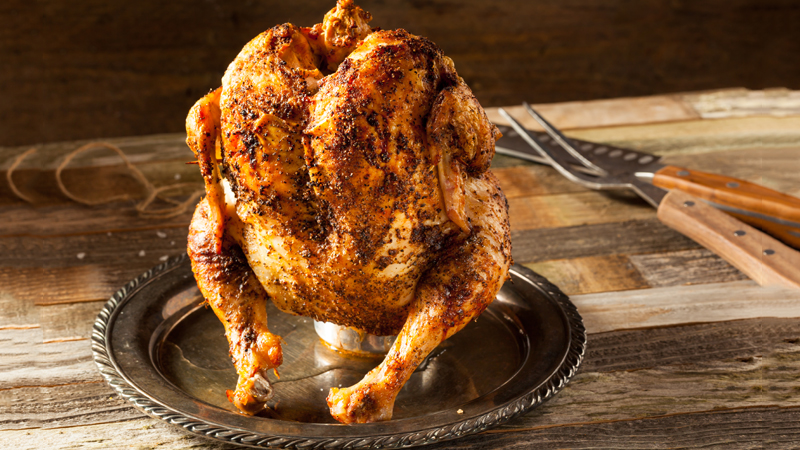
If you Instagram one meal this month, make it a beer-can chicken. Few dishes are as visually compelling as a whole bird hoisted aloft a nobly grease-stained beer can. Bronzed on the grill or in your oven, it’s a show-stopping dish that is surprisingly easy to execute.
“Seeing a chicken upright on a can of beer just brings so much delight and pleasure,” Steven Raichlen, a James Beard Award-winning barbecue expert who quite literally wrote the book on beer-can chicken, says. “We eat with our eyes as well as our palates.”
It’s not a gimmick, either. Beer-can chicken is reliably delicious. You can use different rubs or barbecue sauces, adjusting flavors and spice levels to taste. The process is forgiving enough to use a run-of-the-mill supermarket roaster, or the best fowl you can afford.
Cynics say you can use pretty much any beverage to prop up the bird, from macro lagers to craft IPAs to cranberry juice cocktails, and no one will taste the difference. But these people probably didn‘t roast six chickens atop different beers consecutively, and then analyze bites from each iteration in rapid succession.
To determine the best beers for your bird, we did exactly that. We cooked a lot of chicken. We sipped a lot of beer. We set off smoke detectors on four separate occasions, scrubbed a beer-stained oven interior for 20 minutes straight, and then immediately activated another fire alarm.
We did it all for you and we would do it all again. Beer-can chicken really is that good.
Why It Works
It’s a simple process with stellar kitchen science.
Usually, when you roast chicken in a pan, the bird lies flat on its back. When you take it out of the oven, fully cooked and ready to carve, the top half will be burnished a lovely golden color. The bottom half sat in the pan drippings as it cooked, so that skin will be pale and soggy.
There are a few ways to combat this problem. Some cooks swear by butterflying or spatchcocking. Others buy fancy roasting pans with wire racks that keep the bird above its juices. Those with rotisseries skewer their poultry whole.
Beer cans are an economical and remarkably effective way to keep the chicken out of the drippings. “The vertical position helps drain out excess fat,” Raichlen says, so your chicken skin “gets crisp all around.”
Where It Comes From
“Beer can chicken is cooking born of indulgent goofing around, the ‘what if we put that in there?’ thinking that brought us culinary epiphanies like Reese’s Cups and haggis,” William Bostwick, author of “Beer Craft,” writes.
Unsurprisingly, it is an utterly American invention. Raichlen traces its origins to a Memphis barbecue competition circa 1995 where he spotted a competitor, Bryce Boar Blazer, cooking chicken on beer cans.
“My bet is it didn’t originate much earlier than that,” Raichlen says. “It’s too cool. The minute people saw it, it had to have spread instantly.”
Raichlen did his part to bring beer-can chicken to the masses. He made beer-can chicken on the Food Network, published recipes far and wide, and developed a device to help home cooks protect their beer-can chickens from spills and splatters. For many cooks his name has become synonymous with the process.
“I did not invent it,” Raichlen says, “But I was the person who brought it from the barbecue world to the mainstream.”
Beer Matters
Though this runs afowl of the conventional wisdom, our test kitchen actually found that different brews dramatically altered the flavor of our finished chickens.
IPAs do not make the chicken bitter, as one might expect, but they don’t impart the same toasty, malty flavors as lagers. The citrusy notes of a shandy are pleasantly discernible, and sours and goses are reminiscent of salty, herbaceous poultry rubs.
Our favorites were SouthNorte Agave Mente, Westbrook Gose, and Narragansett Shandy. Yuengling and Budweiser were virtually indistinguishable from one another, and gave the chicken toasty, malty flavors.
You can absolutely customize flavors by adding spices or citrus wedges to any can of beer before mounting your chicken. Try squeezing a quarter lime into a half-empty Corona or Tecate can, for example; or stuff parsley stems, thyme sprigs, and lemon into a Bud. The flavors won’t be as pronounced as with a fruited beer, but they will impact the finished product.
Structurally speaking, tall-boys are a mixed bag. Keeping the chicken elevated helps its skin crisp evenly, but the entire operation is wobblier than a chicken roasted on a 12-ounce can.
All told, there is no wrong beer here. Beer-can chicken is like cheap NYC dollar pizza: Even when it’s “bad,” it’s still pretty great.

Recipe
Cooking a chicken atop a can of beer is an excellent culinary sleight of hand. It provides maximum rewards for minimal effort, and is easily customized with different rubs, sauces, and, of course, beers.
Ingredients
- 1 whole chicken, approximately 4-6 pounds
- Spice rub (recipes follow)
- 1 can of beer, open and half-emptied. We like Naragansett Shandy, Westbrook Gose, and SouthNorte Agave Mente.
Basic Spice Rub
- 4 tablespoons paprika
- 1 tablespoon brown sugar
- 1 tablespoon white sugar
- 1 tablespoon kosher salt
- ½ tablespoon freshly ground black pepper
Fiery Spice Rub
- 3 tablespoons paprika
- 1 tablespoon chili powder
- ½ tablespoon sumac
- ½ tablespoon cumin
- 1 tablespoon brown sugar
- 1 tablespoon white sugar
- 1 tablespoon kosher salt
- 1 tablespoon freshly ground black pepper
Process
- Heat the oven to 425. Position oven racks on the lowest two rungs, and slide a baking sheet onto the bottom rack to catch any spills.
- Remove giblets from chicken and dry it with paper towels.
- Rub the spice mixture into the exterior and interior of the bird. Don’t be shy here; really get into every nook and cranny of the legs and wings.
- Place a half-empty beer in the center of an oven-safe skillet. Gently ease the bird onto the can, wedging the beer into its lower cavity.
- Carefully slide the skillet, can, and bird into your oven, on the shelf above the baking sheet. It will be slightly wobbly, so use tongs or a clean hand to hold the bird in place.
- Cook for 45 minutes, and then cover the bird with tented aluminum foil. This will prevent the skin from burning.
- Cook, covered, for another 30 to 40 minutes, until a thermometer inserted in the crease between the thigh and body reads 165 F.
- Let the chicken rest for 10 minutes. Then, dislodge the beer can (caution: it will be hot), carve the bird, and serve.
